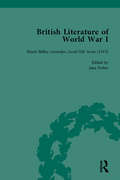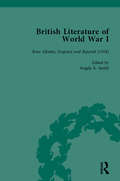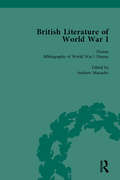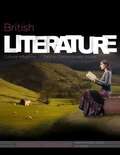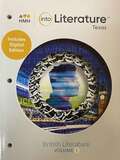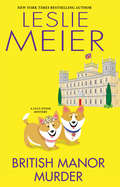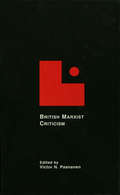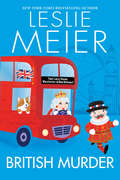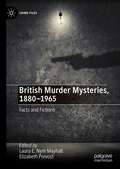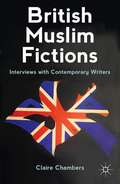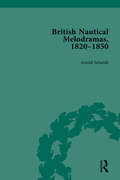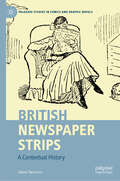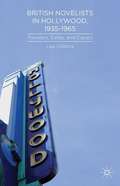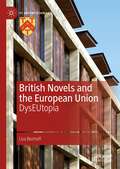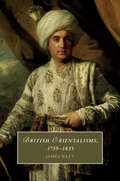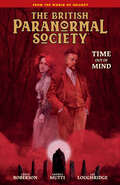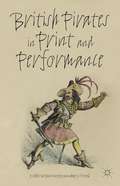- Table View
- List View
British Literature of World War I, Volume 3
by Trudi Tate Jane Potter Andrew Maunder Angela K SmithGiven the popular and scholarly interest in the First World War it is surprising how little contemporary literary work is available. This five-volume reset edition aims to redress this balance, making available an extensive collection of newly-edited short stories, novels and plays from 1914–19.
British Literature of World War I, Volume 4
by Trudi Tate Jane Potter Andrew Maunder Angela K SmithGiven the popular and scholarly interest in the First World War it is surprising how little contemporary literary work is available. This five-volume reset edition aims to redress this balance, making available an extensive collection of newly-edited short stories, novels and plays from 1914–19.
British Literature of World War I, Volume 5
by Trudi Tate Jane Potter Andrew Maunder Angela K SmithGiven the popular and scholarly interest in the First World War it is surprising how little contemporary literary work is available. This five-volume reset edition aims to redress this balance, making available an extensive collection of newly-edited short stories, novels and plays from 1914–19.
British Literature-Student
by James P. StobaughEnjoy beloved classics while developing vocabulary, reading, and critical thinking skills! Each literature book in the series is a one-year course Each chapter has five lessons with daily concept-building exercises, warm-up questions, and guided readings Easy-to-use with suggested reading schedules and daily calendar Equips students to think critically about philosophy and trends in culture, and articulate their views through writing A well-crafted presentation of whole-book or whole-work selections from the major genres of classic literature (prose, poetry, and drama), each course has 34 chapters representing 34 weeks of study, with an overview of narrative background material on the writers, their historical settings, and worldview. The rich curriculum's content is infused with critical thinking skills, and an easy-to-use teacher's guide outlines student objectives with each chapter, providing the answers to the assignments and weekly exercises. The final lesson of the week includes both the exam, covering insights on the week's chapter, as well as essays developed through the course of that week's study, chosen by the educator and student to personalize the coursework for the individual learner.
British Literature-Teacher
by James P. StobaughEnjoy beloved classics while developing vocabulary, reading, and critical thinking skills! Each literature book in the series is a one-year course Each chapter has five lessons with daily concept-building exercises, warm-up questions, and guided readings Easy-to-use with suggested reading schedules and daily calendar Equips students to think critically about philosophy and trends in culture, and articulate their views through writing A well-crafted presentation of whole-book or whole-work selections from the major genres of classic literature (prose, poetry, and drama), each course has 34 chapters representing 34 weeks of study, with an overview of narrative background material on the writers, their historical settings, and worldview. The rich curriculum's content is infused with critical thinking skills, and an easy-to-use teacher's guide outlines student objectives with each chapter, providing the answers to the assignments and weekly exercises. The final lesson of the week includes both the exam, covering insights on the week's chapter, as well as essays developed through the course of that week's study, chosen by the educator and student to personalize the coursework for the individual learner.
British Literature: Romantic Era to the Twentieth Century and Beyond
by B J RobinsonThis open anthology of British Literature encompasses the following eras: Romantic, Victorian, and Twentieth Century and Beyond. The selections represent the literature developed and developing within and through their respective eras. Considering the limitations that the very act of anthologizing imposes, not all that could be representative is included. But what is included, hopefully, is literature that was shaped by its era and that helped shape the literature that followed. This anthology includes contextualizing Introductions to each era, Biographies of each author, and Reading and Review Questions on each author's included works. This material offers basic signposts toward critical interpretation and understanding of the selections. But they do not impose or intend to shape that understanding so students can instead hone their critical thinking skills and synthesize historical, cultural, and aesthetic concepts. With this open anthology, students can compare the selections both within and across historical eras to analyze shared themes. The theme of personal identity as inherent or as socially constructed opens a constellation of related themes, many of which students may take for granted or have not critically examined. Students can understand the revolutionary aspects of the Romantic era by considering how static and determined class distinctions of the eighteenth century became more fluid and conditional in the nineteenth century. They can understand how the Romantics, seeing past sources of identity within a stable class system catastrophically disrupted by revolutionary forces across Europe and ultimately within England, considered universal elements of individuality that were shared across all classes and that demonstrated fundamental equality among humans. Imagination became a touchstone of such shared humanity. Considering the theme of Imagination opens related themes of dream and nightmare, happiness and terror, truth and doubt (or self-truths and self-doubts). Categories of identity constructs--such as hero and monster--similarly become conditional or conditioned, for example, upon self-realization and social limitations. Students can consider how one era's literature influenced the next. Victorian poetry can suggest how revelation of self could be made objective and impersonal through dramatized monologues. A speaker's point of view can reveal truths about humanity--such as jealousy, control, hatred, and greed--that evoke both sympathy and rejection. Impersonality can then lead to the shifting impersonations of Modern literature. Ego and egotism can be deplored by Victorian writers but desired by the Moderns. The horrors of the twentieth century can subvert the heroics of the nineteenth. And the realization of these horrors can grow out of the very sense of individual rights that the Romantics expressed--rights shared across gender, race, and class. This anthology hopefully will open students (and readers) to the conversation that literature has held with readers in the past and is holding with us now.
British Literature: Volume 1; Grade 12 (HMH into Literature, Texas Edition)
by Kylene Beersinto Literature, Texas Edition, British Literature; Volume 1; Grade 12
British Manor Murder (A Lucy Stone Mystery #23)
by Leslie Meier&“Counts, countesses, and corpses highlight Lucy Stone&’s trip across the pond&” in this mystery from the New York Times-bestselling author (Kirkus Reviews). It&’s a nippy spring in Tinker&’s Cove, Maine, and Lucy Stone can&’t wait to join her friend Sue in England for a hat exhibition. But at Moreton Manor, privileged life isn&’t always tea and crumpets. Though the earl and his sister are surprisingly accommodating to their jetlagged guests, Lucy feels uneasy after a fallen portrait sparks talk of a deadly family omen. The bad vibes come quickly—snobby Aunt Millicent and her handmaiden Harrison unexpectedly drop by for the exhibition, and meals with the family are consistently tense. But real trouble begins when a body, bludgeoned by the chapel&’s gold-plated reliquary, is found in a hidden, sealed off room. Stranger still, the corpse is identified as Harrison&’s son, Cyril. While Cyril wasn&’t exactly a gentleman, and it&’s unclear what business he had on the property, one thing&’s for sure—the criminal is privy to Moreton Manor secrets. And Lucy has a hunch that the killer&’s been in her company all along, waiting for a chance to make blue blood run red… &“Engaging…Anglophiles will find plenty to like in this delightful cozy.&”—Publishers Weekly &“Reading a new Leslie Meier mystery is like catching up with a dear old friend.&”—Kate Carlisle, New York Times bestselling author
British Marxist Criticism (Wellesley Studies In Critical Theory, Literary History And Culture Ser. #22)
by Victor N. PaananenBritish Marxist Criticism provides selective but extensive annotated bibliographies, introductory essays, and important pieces of work from each of eight British critics who sought to explain literary production according to the principles of Marxism.
British Marxist Criticism (Wellesley Studies in Critical Theory, Literary History and Culture #22)
by Victor N. PaananenBritish Marxist Criticism provides selective but extensive annotated bibliographies, introductory essays, and important pieces of work from each of eight British critics who sought to explain literary production according to the principles of Marxism.
British Masculinity in the Gentleman's Magazine, 1731 to 1815 (Genders And Sexualities In History Ser.)
by Gillian WilliamsonThe Gentleman's Magazine was the leading eighteenth-century periodical. By integrating the magazine's history, readers and contents this study shows how 'gentlemanliness' was reshaped to accommodate their social and political ambitions.
British Multicultural Literature and Superdiversity
by Ulla RahbekThis book explores contemporary British multicultural multi-genre literature. Considering socio-political and philosophical ideas about British multiculturalism, superdiversity and conviviality, Ulla Rahbek studies a broad range of texts by writers from across the majority-minority divide. The text focuses on figurative registers and metaphorical richness in multicultural poetry and investigates the interlocked issue of recognition, representation and identity in memoirs. Rahbek analyses how twenty-first-century British multicultural novels both envision and reimagine an inclusive nation and thematise the detrimental effects of individual exclusion on characters’ pursuits of the good life. She observes the ways that short stories pivot on ambivalent encounters and intercultural dialogue, and she reflects on the public good of multicultural literature.
British Murder (A Lucy Stone Mystery #23)
by Leslie MeierLucy Stone’s hometown of Tinker’s Cove, Maine, is where her heart is. But traveling to merry old England brings delightful adventure—along with a helping or two or murder—in these beloved mysteries . . . ENGLISH TEA MURDERA trip to England, sponsored by Winchester College, sounds practically perfect to Lucy Stone—until the tour leader suffers a fatal asthma attack mid-flight. Lucy suspects some very unnatural causes, but luckily, she packed her sleuthing skills. Between stops for afternoon tea, visits to historic sites, and catching up with an old flame, she’s ensnared in a daring scheme. But will it lead her to a criminal mastermind—or ensure that she’s the next victim? BRITISH MANOR MURDERLucy can’t wait to join her friend Sue for a gala hat show at the English country house owned by the Earl of Wickham. But at Moreton Manor, there are secrets—and some unpleasant relatives—lurking among the elaborate chapeaus. When a bludgeoned body is found in a hidden room, Lucy must sift through friends and family foes to find the low-down killer stalking the upper crust, before more blue blood runs red . . .
British Murder Mysteries, 1880-1965: Facts and Fictions (Crime Files)
by Laura E. Nym Mayhall Elizabeth PrevostBritish Murder Mysteries, 1880-1965: Facts and Fictions conceptualizes detective fiction as an archive, i.e., a trove of documents and sources to be used for historical interpretation. By framing the genre as a shifting set of values, definitions, and practices, the book historicizes the contested meanings of analytical categories like class, race, gender, nation, and empire that have been applied to the forms and functions of detection. Three organizing themes structure this investigation: fictive facticity, genre fluidity, and conservative modernity. This volume thus shows how British detective fiction from the late-nineteenth to the mid-twentieth century both shaped and was shaped by its social, cultural, and political contexts and the lived experience of its authors and readers at critical moments in time.
British Muslim Fictions
by Claire ChambersThrough interviews with leading writers (including Ahdaf Soueif and Hanif Kureishi), this book analyzes the writing and opinions of novelists of Muslim heritage based in the UK. Discussion centres on writers' work, literary techniques, and influences, and on their views of such issues as the hijab, the war on terror and the Rushdie Affair.
British Nautical Melodramas, 1820–1850: Volume I
by Arnold SchmidtDuring the 1820s and 30s nautical melodramas "reigned supreme" on London stages, entertaining the mariners and maritime workers who comprised a large part of the audience for small theatres with the same sentimental moments and comic interludes of domestic melodrama mixed with patriotic images that communicated and reinforced imperial themes. However, generally the study of British theatre history moves from medieval and renaissance plays directly to the realism and naturalism of late Victorian and modern drama. Readers typically encounter a gap between Restoration and eighteenth-century plays like those of Oliver Goldsmith and Richard Brinsley Sheridan, and late-nineteenth plays by Henrik Ibsen and Oscar Wilde. Nineteenth-century drama, with the possible exception of plays by Byron, Shelley, and Wordsworth, remains all but invisible. Until recently, melodramatic plays written and performed during this "gap" received little scholarly attention, but their value as reflections of Britain’s promulgation of imperial ideology — and its role in constructing and maintaining class, gender, and racial identities — have given discussions of melodrama force and momentum. The plays in included in these three volumes have never appeared in a critical anthology and most have not been republished since their original nineteenth-century editions. Each play is transcribed from the original documents and includes an author biography, a headnote about the play itself, full annotations with brief definitions of unfamiliar vocabulary, and explanatory notes. Comprehensive editorial apparatus details the nineteenth-century imperial, naval, political, and social history relevant to the plays’ nautical themes, as well as discussing nineteenth-century theatre history, melodrama generally, and the nautical melodrama in particular. Contemporary theatre practices — acting, audiences, staging, lighting, special effects — are also examined. An extensive bibliography of primary and secondary texts; a complete index; and contemporary images of the actors, theatres, stage sets, playbills, costumes, and locales have been compiled to aid study further. The appendices include maps of Britain, Europe, and the East and West Indies.
British Nautical Melodramas, 1820–1850: Volume II
by Arnold SchmidtDuring the 1820s and 30s nautical melodramas "reigned supreme" on London stages, entertaining the mariners and maritime workers who comprised a large part of the audience for small theatres with the same sentimental moments and comic interludes of domestic melodrama mixed with patriotic images that communicated and reinforced imperial themes. However, generally the study of British theatre history moves from medieval and renaissance plays directly to the realism and naturalism of late Victorian and modern drama. Readers typically encounter a gap between Restoration and eighteenth-century plays like those of Oliver Goldsmith and Richard Brinsley Sheridan, and late-nineteenth plays by Henrik Ibsen and Oscar Wilde. Nineteenth-century drama, with the possible exception of plays by Byron, Shelley, and Wordsworth, remains all but invisible. Until recently, melodramatic plays written and performed during this "gap" received little scholarly attention, but their value as reflections of Britain’s promulgation of imperial ideology — and its role in constructing and maintaining class, gender, and racial identities — have given discussions of melodrama force and momentum. The plays in included in these three volumes have never appeared in a critical anthology and most have not been republished since their original nineteenth-century editions. Each play is transcribed from the original documents and includes an author biography, a headnote about the play itself, full annotations with brief definitions of unfamiliar vocabulary, and explanatory notes. Comprehensive editorial apparatus details the nineteenth-century imperial, naval, political, and social history relevant to the plays’ nautical themes, as well as discussing nineteenth-century theatre history, melodrama generally, and the nautical melodrama in particular. Contemporary theatre practices — acting, audiences, staging, lighting, special effects — are also examined. An extensive bibliography of primary and secondary texts; a complete index; and contemporary images of the actors, theatres, stage sets, playbills, costumes, and locales have been compiled to aid study further. The appendices include maps of Britain, Europe, and the East and West Indies.
British Nautical Melodramas, 1820–1850: Volume III
by Arnold SchmidtDuring the 1820s and 30s nautical melodramas "reigned supreme" on London stages, entertaining the mariners and maritime workers who comprised a large part of the audience for small theatres with the same sentimental moments and comic interludes of domestic melodrama mixed with patriotic images that communicated and reinforced imperial themes. However, generally the study of British theatre history moves from medieval and renaissance plays directly to the realism and naturalism of late Victorian and modern drama. Readers typically encounter a gap between Restoration and eighteenth-century plays like those of Oliver Goldsmith and Richard Brinsley Sheridan, and late-nineteenth plays by Henrik Ibsen and Oscar Wilde. Nineteenth-century drama, with the possible exception of plays by Byron, Shelley, and Wordsworth, remains all but invisible. Until recently, melodramatic plays written and performed during this "gap" received little scholarly attention, but their value as reflections of Britain’s promulgation of imperial ideology — and its role in constructing and maintaining class, gender, and racial identities — have given discussions of melodrama force and momentum. The plays in included in these three volumes have never appeared in a critical anthology and most have not been republished since their original nineteenth-century editions. Each play is transcribed from the original documents and includes an author biography, a headnote about the play itself, full annotations with brief definitions of unfamiliar vocabulary, and explanatory notes. Comprehensive editorial apparatus details the nineteenth-century imperial, naval, political, and social history relevant to the plays’ nautical themes, as well as discussing nineteenth-century theatre history, melodrama generally, and the nautical melodrama in particular. Contemporary theatre practices — acting, audiences, staging, lighting, special effects — are also examined. An extensive bibliography of primary and secondary texts; a complete index; and contemporary images of the actors, theatres, stage sets, playbills, costumes, and locales have been compiled to aid study further. The appendices include maps of Britain, Europe, and the East and West Indies.
British Newspaper Strips: A Contextual History (Palgrave Studies in Comics and Graphic Novels)
by Adam TwycrossThis book explores the history and development of the British daily newspaper strip. It considers such strips within their political, commercial and societal contexts and fills in a crucial section of publishing history that has been largely overlooked by both comics and newspaper studies to date. Beginning with an examination of the role of the image within British publishing in the final decades of the nineteenth century, the book moves on to explore the arrival and development of the first daily strips. It considers the links that bound these strips to surrounding cultural forms, their relationship to their host newspapers, and their position within the wider structures of the emerging popular press. Subsequent chapters cover a range of topics including the impact of the world wars, the anti-comics campaigns of the 1940s and 50s, and how changes to British publishing and wider society shaped the newspaper strips of the final decades of the twentieth century. Culminating with a discussion of the way in which strips became established within the broadsheet press from the 1960s, the book builds to provide a detailed overview of the twentieth century development of this most neglected cultural form.
British Novelists in Hollywood, 1935-1965: Travelers, Exiles, and Expats
by Lisa CollettaBritish Novelists in Hollywood, 1935-1965 calls attention to the shifting grounds of cultural expression by highlighting Hollywood as a site that unsettled definitions and narratives of colonialism and national identity for prominent British novelists such as Christopher Isherwood, P. G. Wodehouse, Evelyn Waugh, and J. B. Priestley.
British Novels and the European Union: DysEUtopia (St Antony's Series)
by Lisa BischoffThis book looks at the cultural, political and economic conditions of British Euroscepticism. Focusing on eight British dystopian novels, published in the years before the decisive In/Out-Referendum, and taking into account cultural, political and economic contexts, Lisa Bischoff shows how the novels’ stance towards the integration project range from slight criticism to outright hostility. The wide availability of the novels, and the prominence of both its authors and readers, among which are political figures David Cameron, Nigel Farage and Daniel Hannan, amplify the power of literary Euroscepticism. Drawing on cultural studies, literature and social science, British Novels and the European Union reveals the many facets of British Euroscepticism.
British Orientalisms, 1759–1835 (Cambridge Studies in Romanticism #126)
by James WattHow did Britons understand their relationship with the East in the late eighteenth and early nineteenth centuries? James Watt's new study remaps the literary history of British Orientalisms between 1759, the 'year of victories' in the Seven Years' War, and 1835, when T. B. Macaulay published his polemical 'Minute on Indian Education'. It explores the impact of the war on Britons' cultural horizons, and the different and shifting ways in which Britons conceived of themselves and their nation as 'open' to the East across this period. Considering the emergence of new forms and styles of writing in the context of an age of empire and revolution, Watt examines how the familiar 'Eastern' fictions of the past were adapted, reworked, and reacted against. In doing so he illuminates the larger cultural conflict which animated a nation debating with itself about its place in the world and relation to its others.
British Paranormal Society: Time Out of Mind
by Chris Roberson Mike MignolaBritish Paranormal Society members Simon Bruttenholm and Honora Grant arrive at Noxton together, but with separate goals: Honora hopes to uncover information on the town&’s strange traditions, while Simon is searching for his missing assistant.But their separate investigations lead down the same twisted path that hides a dark secret behind Noxton&’s innocent façade!Mike Mignola and Chris Roberson expand the Hellboy universe with a spooky new tale featuring art by Andrea Mutti with colors by Lee Loughridge, collected for the first time in hardcover.Collects British Paranormal Society: Time Out of Mind #1–#5.
British Pirates in Print and Performance
by Frederick BurwickFictional or real, pirates haunted the imagination of the 18th and 19th century-British public during this great period of maritime commerce, exploration, and naval conflict. British Pirates in Print and Performanc e explores representations of pirates through dozens of stage performances, including adaptations by Byron, Scott, and Cooper.
British Poetry 1964 to 1984: Driving through the Barricades (Routledge Revivals)
by Martin BoothFirst published in 1985, British Poetry presents a personal and political account of British poetry from 1964 to 1984. Martin booth, himself a poet, poetry publisher, critic and editor, and the participant in poetry readings in Britain and overseas, shows that British poetry underwent a renaissance in the ten years from around 1964: poetry became a major popular art form, shaking off its shackles of elitism and academicism; poetry readings flourished, whether live or on the air and audiences increased; many new poets found willing publishers. He looks at the manner in which British poetry rose, only to fall back into a morbid sleek artiness where he sees it laying today, once again a narrow art for the literary educated and the initiated.The book aims to reverse this change of direction so that British poetry may once again have the impact it briefly had in its recent heyday. Martin Booth also provides a general guide to the period, with much comment included from those who were involved in the act of keeping British poetry going in those exciting years. He deals with the poets themselves, with the publishing of poetry, and poetry magazines, and his ‘non-literary’, ‘non-academic’ approach will appeal to all those who have an interest in modern British verse.
